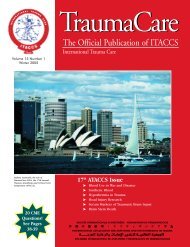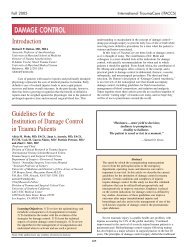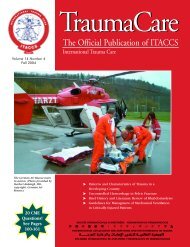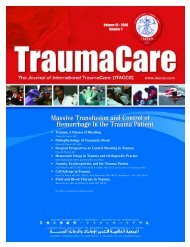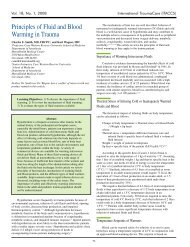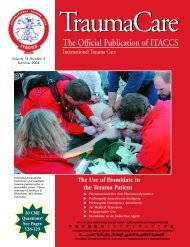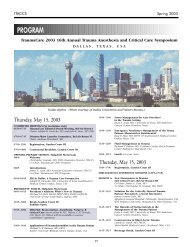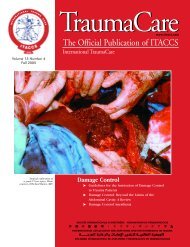The Official Publication of ITACCS - International Trauma ...
The Official Publication of ITACCS - International Trauma ...
The Official Publication of ITACCS - International Trauma ...
Create successful ePaper yourself
Turn your PDF publications into a flip-book with our unique Google optimized e-Paper software.
<strong>ITACCS</strong> Spring 2003<br />
Fluid Management in <strong>Trauma</strong><br />
Richard P. Dutton, MD<br />
R Adams Cowley Shock <strong>Trauma</strong> Center, University <strong>of</strong> Maryland, Baltimore, Maryland, USA<br />
Learning Objective: To better understand the anesthesiologist’s role in controlling<br />
life-threatening hemorrhage.<br />
Fluid resuscitation is a rapidly evolving area <strong>of</strong> trauma practice, particularly in early<br />
hemorrhagic shock (while the patient is still actively bleeding). <strong>The</strong> surgeons have brought<br />
new diagnostic and therapeutic options to the table, including FAST, angiography, and damage<br />
control techniques. What has anesthesia contributed?<br />
I will briefly review the history and recent academic literature on early resuscitation,<br />
including the arguments for and against deliberate hypotensive management, early use <strong>of</strong><br />
blood products, hypothermia, hypertonic resuscitation fluids, and pro-coagulants. <strong>The</strong> anesthesiologist<br />
plays a critical role in the application <strong>of</strong> each <strong>of</strong> these therapies and should be<br />
familiar with the evidence that supports their use.<br />
I will conclude with a discussion <strong>of</strong> over-the-horizon approaches to hemorrhagic<br />
shock, including new diagnostic modalities, new treatment options, and new approaches to<br />
long-term resuscitation and prevention <strong>of</strong> organ system failure.<br />
[Editors’ note re “<strong>of</strong>f-label” use: Dr. Dutton will discuss investigational and anecdotal<br />
use <strong>of</strong> dry fibrin sealant bandages, hemoglobin-based oxygen carriers, and recombinant FVIIa.]<br />
Thursday, May 15, 2003<br />
Simultaneous Afternoon Sessions<br />
— Session A —<br />
New Dimensions in <strong>Trauma</strong> and Critical Care<br />
Co-Chair: James G. Cain, MD<br />
Co-Chair: Christopher M. Grande, MD, MPH<br />
Sedation for the Critically Injured <strong>Trauma</strong> Patient: Precedex®, a Novel Alternative<br />
James Gordon Cain, MD<br />
Allegheny General Hospital, Pittsburgh, Pennsylvania, and West Virginia University,<br />
Morgantown, West Virginia, USA<br />
Learning Objective: To provide an introduction to dexmedetomidine, a newly<br />
introduced alpha 2 blocking sedative-analgesic, and its use in critically ill trauma patients.<br />
Dexmedetomidine (Precedex®), a lipophilic imidazole derivative, selective alpha2<br />
agonist (1300:1, a2:a1), is approved for use in initially intubated critically ill patients.<br />
Precedex® <strong>of</strong>fers analgesia, sedation, inhibition <strong>of</strong> shivering, decreased sympathetic outflow,<br />
and decreased catecholamines without significantly decreasing respiratory drive. With this<br />
decrease in sympathetic outflow, mild to moderate hypotension and bradycardia may occur.<br />
Precedex® does not have a direct myocardial effect. A novel aspect <strong>of</strong> Precedex® is that,<br />
compared with an equal level <strong>of</strong> baseline sedation with standard agents, it allows easy arousability.<br />
This would be particularly advantageous in facilitating reproducible, serial neurologic<br />
examinations at will in patients with TBI while avoiding the drastic swings in sedation with<br />
volatile hemodynamics associated with the current prop<strong>of</strong>ol-based technique.<br />
Dexmedetomidine reduced prop<strong>of</strong>ol and morphine requirements and improved hemodynamic<br />
stability during bispectral (BIS) index-guided intensive care unit sedation. Additional<br />
benefits <strong>of</strong> Precedex® may be a modest decrease in cerebral blood flow, along with additional<br />
neuroprotective properties in its own right.<br />
Bibliography<br />
Hall JE, Uhrich TD, Barney JA, et al. Sedative, amnestic, and analgesic properties <strong>of</strong><br />
small-dose dexmedetomidine infusions. Anesth Analg 2000; 90:699–705.<br />
Housmans PR. Effect <strong>of</strong> dexmedetomidine on contractility, relaxation, and intracellular calcium<br />
transients <strong>of</strong> isolated ventricular myocardium. Anesthesiology 1990; 73:919–22.<br />
Jolkkonen J, Puurunen K, Koistinaho J, et al. Neuroprotection by the alpha2-adrenoreceptor<br />
agonist, dexmedetomidine, in rat focal cerebral ischemia. Eur J Pharmacol<br />
1999; 372:31–6.<br />
Kuhmonen J, Pokorny J, Miettinen R, et al. Neuroprotective effects <strong>of</strong> dexmedetomidine<br />
in the gerbil hippocampus after transient global ischemia. Anesthesiology<br />
1997; 87:371–7.<br />
Prielipp RC, Wall MH, Tobin JR, et al. Dexmedetomidine-induced sedation in volunteers<br />
decreases regional and global blood flow. Anesth Analg 2002; 95:1052–9.<br />
Takrouri MS, Seraj MA, Channa AB, et al. Dexmedetomidine in the intensive care unit:<br />
a study <strong>of</strong> hemodynamic changes. Middle East J Anesthesiol 2002;16:587–95.<br />
Talke P, Li J, Jain U, et al. Effects <strong>of</strong> perioperative dexmedetomidine infusion in patients<br />
undergoing vascular surgery. <strong>The</strong> Study <strong>of</strong> Perioperative Ischemia Research Group.<br />
Anesthesiology 1995; 82:620–33.<br />
Triltsch AE, Welte M, von Homeyer P, et al. Bispectral index-guided sedation with<br />
dexmedetomidine in intensive care: a prospective randomized, double blind, placebo-controlled<br />
phase II study. Crit Care Med 2002; 30:1007–14.<br />
Venn RM, Bradshaw CJ, Spencer R, et al. Preliminary UK experience <strong>of</strong> dexmedetomidine,<br />
a novel agent for postoperative sedation in the intensive care unit.<br />
Anaesthesia 1999; 54:1136–42.<br />
Venn RM, Bryant A, Hall GM, Grounds RM. Effects <strong>of</strong> dexmedetomidine on adrenocortical<br />
function, and the cardiovascular, endocrine and inflammatory responses in<br />
post-operative patients needing sedation in the intensive care unit. Br J Anaesth<br />
2001; 86:650–6.<br />
Venn RM, Hell J, Grounds RM. Respiratory effects <strong>of</strong> dexmedetomidine in the surgical<br />
patient requiring intensive care. Crit Care 2000; 4:302–8.<br />
<strong>The</strong> Hazards <strong>of</strong> Nutraceuticals in the Management <strong>of</strong> the <strong>Trauma</strong> Patient<br />
Jessie A. Leak, MD<br />
Associate Pr<strong>of</strong>essor <strong>of</strong> Anesthesiology<br />
University <strong>of</strong> Texas, MD Anderson Cancer Center, Houston, Texas, USA<br />
Learning Objectives: 1) To outline the herbs and dietary supplements (nutraceuticals)<br />
that are most commonly used in the preoperative phase; 2) to discuss the various<br />
preparations in which these products are available; 3) to broadly cover the state <strong>of</strong> government<br />
regulation <strong>of</strong> these products; and 4) most importantly, to target some <strong>of</strong> the more<br />
important potential drug-nutraceutical interactions and hazards, particularly as they<br />
may relate to the care <strong>of</strong> the patient receiving anesthesia.<br />
Because <strong>of</strong> the paucity <strong>of</strong> government regulation regarding purity, contents, manufacturing,<br />
and health claims as well as pharmacologic and physiologic predictability, it is difficult<br />
to fund and perform double-blind, placebo-controlled studies on these products. For this<br />
reason, much <strong>of</strong> the material concerning potential hazards and adverse drug interactions is<br />
based on extrapolation, anecdote, and/or uncontrolled case studies on active ingredients that<br />
are not consistently available in the products that we purchase in our local pharmacies, grocery<br />
stores, and gyms.<br />
SUMMARY OF POTENTIAL INTRAOPERATIVE COMPLICATIONS<br />
Untoward cardiovascular effects Ephedra<br />
Ginseng<br />
Licorice<br />
St. John’s Wort (potential indirect effect)<br />
Vitamin E<br />
Triiodothyroacetic acid<br />
GBL, BD, GHB<br />
Enhanced bleeding potential<br />
Potential for prolongation<br />
<strong>of</strong> anesthesia<br />
Possible renal insufficiency<br />
or hepatotoxicity<br />
Possible abnormal thyroid functions<br />
Potential for electrolyte disturbances<br />
Risk <strong>of</strong> decreased effectiveness <strong>of</strong><br />
HIV protease inhibitors<br />
Ginseng<br />
Ginkgo<br />
Ginger<br />
Garlic<br />
Feverfew<br />
Vitamin E<br />
Valerian<br />
Kava-kava<br />
St. John’s Wort (anecedotal only)<br />
Licorice (renal)<br />
Creatine (renal)<br />
Echinacea (hepatic)<br />
Kava-kava (hepatic)<br />
Triiodothyroacetic acid<br />
Vitamin E<br />
Goldenseal<br />
Licorice<br />
St. John’s Wort<br />
SUMMARY OF INDIVIDUAL HERBS AND SUPPLEMENTS<br />
Name Common Uses Potential Side Effects<br />
Echinacea Common cold, bronchitis Possibly hepatotoxic. May decrease<br />
effectiveness <strong>of</strong> corticosteroids<br />
Ephedra Diet aid; antitussive Death. Cardiovascular instability. Multiple<br />
drug interactions<br />
Feverfew Migraine prophylactic May inhibit platelet activity and increase<br />
bleeding. Avoid use in pts on anticoagulants.<br />
Garlic Lipid & BP lowering; May potentiate warfarin and increase<br />
Antiplatelet, antioxidant, bleeding; affects platelet aggregation.<br />
anithrombolytic qualities<br />
Ginger Antinauseant May be a potent inhibitor <strong>of</strong> thromboxane<br />
synthetase and may increase bleeding time.<br />
Use with caution with warfarin.<br />
Ginkgo Circulatory stimulant May enhance bleeding in pts on<br />
anticoagulant or antithrombotic therapy.<br />
Ginseng “Adaptogenic” Avoid use with other stimulants—may<br />
Energy level enhancer experience tachycardia or hypertension.<br />
Antioxidant<br />
May increase bleeding, especially in patients<br />
on anticoagulant or antithrombotic therapies.<br />
Known to have anti-platelet properties.<br />
Goldenseal Diuretic; anti-inflammatory Functions as aquaretic, not as diuretic; see<br />
no sodium excretion, just free water<br />
excretion. May worsen edema or<br />
hypertension.<br />
Kava-kava Anxiolytic May potentiate barbiturates and prolong<br />
anesthesia.<br />
Licorice Gastric and duodenal ulcers Glycyrrhizic acid in licorice may cause high<br />
blood pressure, low potassium, and edema.<br />
Contraindicated in renal insufficiency, liver<br />
conditions, hypertonia.<br />
St. John’s Wort Mild to moderate depression May prolong effects <strong>of</strong> anesthesia (anecdotal<br />
Anxiety<br />
only). May decrease effectiveness <strong>of</strong> all HIV<br />
protease inhibitors as well as all nonnucleo<br />
side reverse transcriptase inhibitors. May<br />
decrease blood levels <strong>of</strong> digoxin.<br />
Valerian Sedative May potentiate barbiturates.<br />
41




